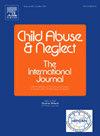在巴西大样本中探索儿童虐待的亚型:共发生模式和相关特征
IF 3.4
2区 心理学
Q1 FAMILY STUDIES
引用次数: 0
摘要
儿童虐待亚型经常同时发生,揭示了以变量为中心的方法可能忽略的复杂的受害模式。在研究不足的地区,理解这些模式具有挑战性,在这些地区,有限的证据阻碍了对不同背景下多重虐待的深入了解。目的根据虐待亚型之间的系统关系,确定儿童虐待亚群,并探讨这些亚群是否因病例特征而存在差异。参与者和环境数据收集自2018年至2022年巴西法定疾病信息系统中记录的123,609份儿童虐待(0-18岁)报告。方法采用3步潜类分析方法,根据身体暴力、心理暴力、性暴力和忽视的发生情况确定虐待亚组,并根据病例特征(年龄、性别、种族/民族、残疾、加害人关系)进行比较。结果确定了四个类别:“多重受害”(19.4%)、“性暴力”(27.0%)、“忽视”(30.7%)和“身体暴力”(22.9%)。“多重受害”和“性暴力”班级主要是年轻女孩、多种族/多民族个人和残疾人,以父亲/继父或男友/女友为常见犯罪者。男孩在年轻时更容易受到忽视,而在年老时更容易受到身体暴力,忽视往往是由父亲/继父实施的,而两种形式的虐待往往是由母亲/继母实施的。结论:研究结果强调了儿童虐待的异质性,揭示了儿童虐待的共同发生模式,其中年龄较小的儿童、女孩、多种族/多民族背景和残疾儿童的比例过高,往往是在家庭环境中受害。研究结果可以帮助专业人员识别具有高风险特征和常见的受害者-加害者关系的个人,加强发现、报告和有针对性的干预措施,特别是对遭受多重虐待的群体。本文章由计算机程序翻译,如有差异,请以英文原文为准。
Exploring subtypes of child maltreatment in a large Brazilian sample: Co-occurrence patterns and associated characteristics
Background
Child maltreatment subtypes often co-occur, revealing complex victimization patterns that variable-centered approaches may overlook. Understanding these patterns is challenging in under-researched regions, where limited evidence hinders insights into multiple maltreatment in diverse contexts.
Objective
To identify subgroups of child maltreatment based on systematic relationships among the maltreatment subtypes, and to explore whether these subgroups differ according to case characteristics.
Participants and setting
Data were collected from 123,609 reports of child maltreatment (ages 0–18) recorded in Brazil's Notifiable Diseases Information System from 2018 to 2022.
Methods
A 3-step latent class analysis was conducted to identify maltreatment subgroups based on the occurrence of physical, psychological, sexual violence, and neglect, and to compare them according to case characteristics (age, gender, race/ethnicity, disability, and victim–perpetrator relationship).
Results
Four classes were identified: ‘polyvictimization’ (19.4 %), ‘sexual violence’ (27.0 %), ‘neglect’ (30.7 %), and ‘physical violence’ (22.9 %). ‘Polyvictimization’ and ‘sexual violence’ classes were predominantly younger girls, multiracial/multiethnic individuals, and those with disabilities, with fathers/stepfathers or boyfriend/girlfriend as common perpetrators. Boys were more vulnerable to neglect at younger ages and to physical violence at older ages, with neglect often perpetrated by fathers/stepfathers and both forms of maltreatment perpetrated by mothers/stepmothers.
Conclusions
Findings highlight the heterogeneity of child maltreatment, revealing co-occurrence patterns with overrepresentation of younger children, girls, and those from multiracial/multiethnic backgrounds and with disabilities, often victimized in family contexts. Findings can help professionals identify individuals with high-risk profiles and common victim-perpetrator relationships, enhancing detection, reporting, and targeted interventions, particularly for groups disproportionately affected by multiple maltreatment.
求助全文
通过发布文献求助,成功后即可免费获取论文全文。
去求助
来源期刊

Child Abuse & Neglect
Multiple-
CiteScore
7.40
自引率
10.40%
发文量
397
期刊介绍:
Official Publication of the International Society for Prevention of Child Abuse and Neglect. Child Abuse & Neglect The International Journal, provides an international, multidisciplinary forum on all aspects of child abuse and neglect, with special emphasis on prevention and treatment; the scope extends further to all those aspects of life which either favor or hinder child development. While contributions will primarily be from the fields of psychology, psychiatry, social work, medicine, nursing, law enforcement, legislature, education, and anthropology, the Journal encourages the concerned lay individual and child-oriented advocate organizations to contribute.
 求助内容:
求助内容: 应助结果提醒方式:
应助结果提醒方式:


